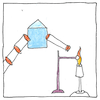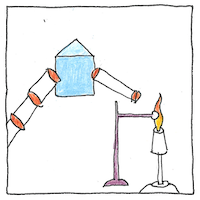Robert Bunsen,
Gustav Kirchhoff
chemistry

|
Analytical spectroscopy
Flame emission spectroscopy came before the Bunsen burner, but the Bunsen burner provided a cleaner, more consistent flame. Glue a sample to a platinum wire and stick it into the flame, heating the sample to glowing atoms, then pass their light through a defraction grating. Each element has a characteristic pattern of wavelengths, its spectrum, produced by their spectroscope. Bunsen and Kirchoff began to systematically correlate chemical elements and chemical compounds with their spectra linking absorption and emission lines, and establishing that spectroscopy can be used to analyze trace chemicals in a sample.
Three laws
1 You get a continuous spectrum from any incandescent material under high pressure. 2 You get an emission-line spectrum from a hot gas under low pressure. 3 You get an absorption-line spectrum from passing a continuous spectrum through a cool gas.
Analysis
I think I could figure out anything, given the right tools and enough time. Rocket scientist, brain surgeon, brain surgeon for a rocket scientist. At least I’m persistent. If you pay me well, I’d buy an analyst’s couch, and I’d be willing for you to do the talking.



In addition to establishing the basis of analytic spectroscopy, Robert Bunsen and Gustav Kirchhoff discovered caesium and rubidium using their spectroscope.
See also in The book of science:
Readings in wikipedia: